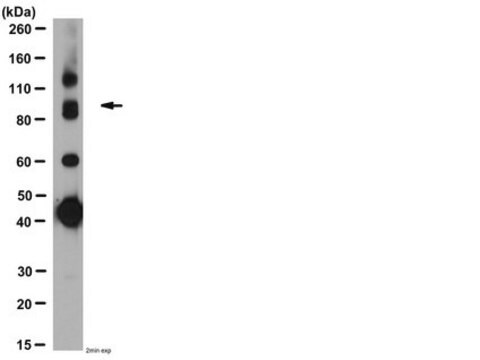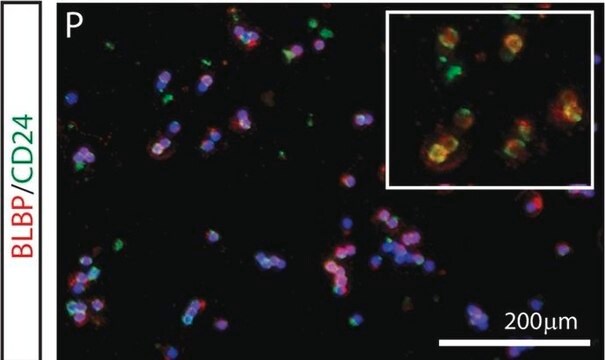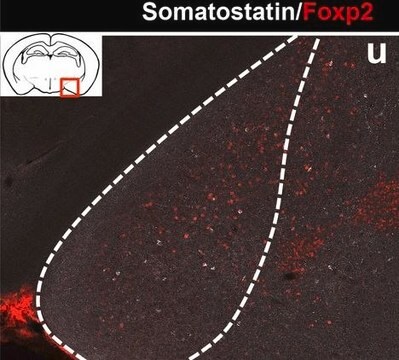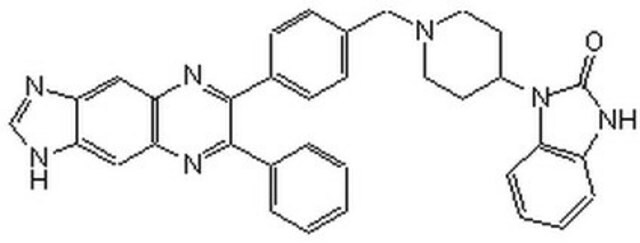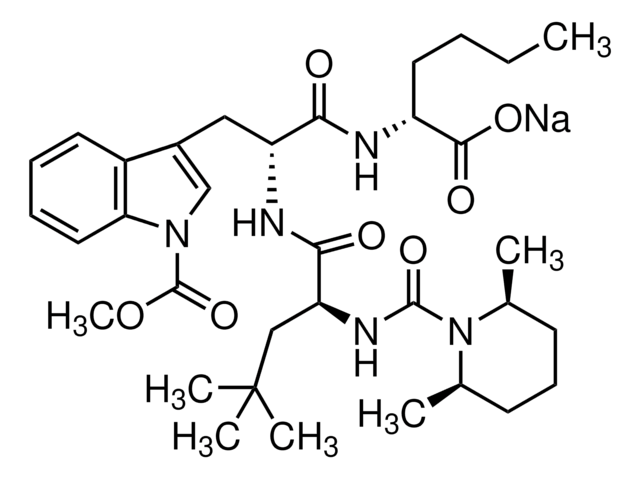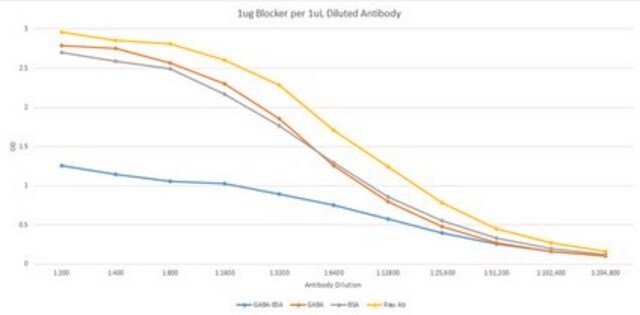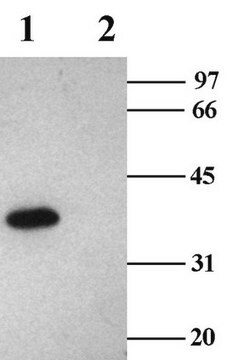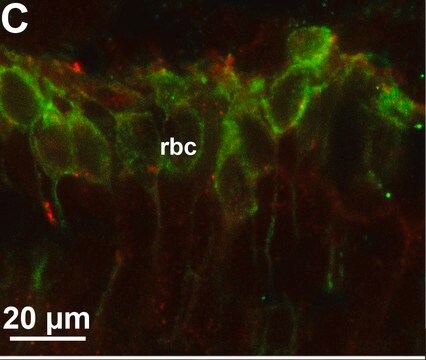AB5360
Anti-Potassium Channel Kv4.2 Antibody
Chemicon®, from rabbit
Sign Into View Organizational & Contract Pricing
All Photos(1)
About This Item
UNSPSC Code:
12352203
eCl@ss:
32160702
NACRES:
NA.41
clone:
polyclonal
application:
WB
species reactivity:
rat
technique(s):
western blot: suitable
citations:
4
Recommended Products
biological source
rabbit
Quality Level
antibody form
affinity purified immunoglobulin
antibody product type
primary antibodies
clone
polyclonal
purified by
affinity chromatography
species reactivity
rat
manufacturer/tradename
Chemicon®
technique(s)
western blot: suitable
NCBI accession no.
UniProt accession no.
shipped in
wet ice
target post-translational modification
unmodified
Gene Information
human ... KCND2(3751)
General description
This Anti-Potassium Channel Kv4.2 Antibody is validated for use in WB for the detection of Potassium Channel Kv4.2.
Specificity
Recognizes Kv4.2 (Shal1, RK5, Kcnd2). The epitope specific for Kv4.2 is not present in any other known proteins.
SPECIES REACTIVITIES: Rat. Reactivity with other species has not yet been tested. It is expected to work on mouse and human because the immunogen sequence is highly homologous (15/16 residues identical).
SPECIES REACTIVITIES: Rat. Reactivity with other species has not yet been tested. It is expected to work on mouse and human because the immunogen sequence is highly homologous (15/16 residues identical).
Immunogen
Highly purified peptide corresponding to residues 454-469 of rat Kv4.2 (Accession Q63881).
Application
Anti-Potassium Channel Kv4.2 Antibody is an antibody against Potassium Channel Kv4.2 for use in WB.
Research Category
Neuroscience
Neuroscience
Research Sub Category
Ion Channels & Transporters
Ion Channels & Transporters
Western blotting: 1:200 using ECL on rat brain membranes.
Immunohistochemistry on rat brain sections.
Immunoprecipitation Dilutions should be made using a carrier protein such as BSA (1-3%).
Optimal working dilutions must be determined by the end user.
Immunohistochemistry on rat brain sections.
Immunoprecipitation Dilutions should be made using a carrier protein such as BSA (1-3%).
Optimal working dilutions must be determined by the end user.
Target description
70 kDa
Physical form
Affinity purified immunoglobulin. Lyophilized from PBS, pH 7.4, containing 1% BSA, and 0.025% sodium azide. Reconstitute with 50 μL of sterile distilled water. Centrifuge antibody preparation before use (10,000 x g for 5 min).
Storage and Stability
Maintain lyophilized material at -20°C for up to 6 months. After reconstitution maintain at -20°C in undiluted aliquots for up to 6 months. Avoid repeated freeze/thaw cycles.
Analysis Note
Control
CONTROL ANTIGEN: Included free of charge with the antibody is 40 μg of control antigen (lyophilized powder). The stock solution of the antigen can be made up using 100 μL of sterile distilled water. For negative control, preincubate 1 μg of purified peptide with 1 μg of antibody for one hour at room temperature. Optimal concentrations must be determined by the end user.
CONTROL ANTIGEN: Included free of charge with the antibody is 40 μg of control antigen (lyophilized powder). The stock solution of the antigen can be made up using 100 μL of sterile distilled water. For negative control, preincubate 1 μg of purified peptide with 1 μg of antibody for one hour at room temperature. Optimal concentrations must be determined by the end user.
Other Notes
Concentration: Please refer to the Certificate of Analysis for the lot-specific concentration.
Legal Information
CHEMICON is a registered trademark of Merck KGaA, Darmstadt, Germany
Disclaimer
Unless otherwise stated in our catalog or other company documentation accompanying the product(s), our products are intended for research use only and are not to be used for any other purpose, which includes but is not limited to, unauthorized commercial uses, in vitro diagnostic uses, ex vivo or in vivo therapeutic uses or any type of consumption or application to humans or animals.
Not finding the right product?
Try our Product Selector Tool.
Hazard Statements
Precautionary Statements
Hazard Classifications
Aquatic Chronic 3
Storage Class Code
11 - Combustible Solids
WGK
WGK 3
Certificates of Analysis (COA)
Search for Certificates of Analysis (COA) by entering the products Lot/Batch Number. Lot and Batch Numbers can be found on a product’s label following the words ‘Lot’ or ‘Batch’.
Already Own This Product?
Find documentation for the products that you have recently purchased in the Document Library.
Wei Zhou et al.
Neuron, 41(4), 573-586 (2004-02-26)
Four Kv channel-interacting proteins (KChIP1 through KChIP4) interact directly with the N-terminal domain of three Shal-type voltage-gated potassium channels (Kv4.1, Kv4.2, and Kv4.3) to modulate cell surface expression and function of Kv4 channels. Here we report a 2.0 Angstrom crystal
Daniel I Levy et al.
The Journal of physiology, 588(Pt 14), 2657-2668 (2010-05-26)
MiRP3, the single-span membrane protein encoded by KCNE4, is localized by immunofluorescence microscopy to the transverse tubules of murine cardiac myocytes. MiRP3 is found to co-localize with Kv4.2 subunits that contribute to cardiac transient outward potassium currents (I(to)). Whole-cell, voltage-clamp
Henry H Jerng et al.
The Journal of physiology, 568(Pt 3), 767-788 (2005-08-27)
Kv4 pore-forming subunits are the principal constituents of the voltage-gated K+ channel underlying somatodendritic subthreshold A-type currents (I(SA)) in neurones. Two structurally distinct types of Kv4 channel modulators, Kv channel-interacting proteins (KChIPs) and dipeptidyl-peptidase-like proteins (DPLs: DPP6 or DPPX, DPP10
Jochen Rose et al.
American journal of physiology. Heart and circulatory physiology, 288(5), H2077-H2087 (2005-01-08)
Action potential (AP) prolongation is a hallmark of failing myocardium. Functional downregulation of K currents is a prominent feature of cells isolated from failing ventricles. The detailed changes in K current expression differ depending on the species, the region of
Our team of scientists has experience in all areas of research including Life Science, Material Science, Chemical Synthesis, Chromatography, Analytical and many others.
Contact Technical Service